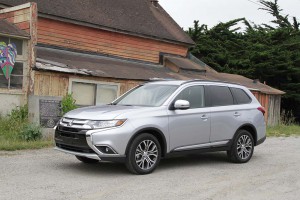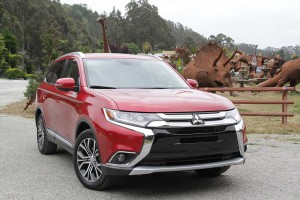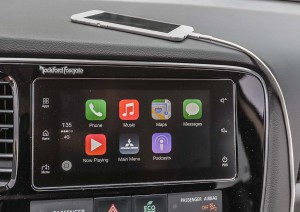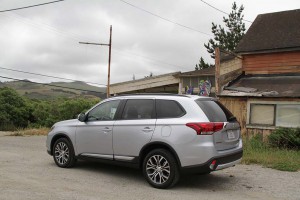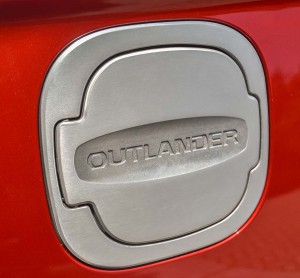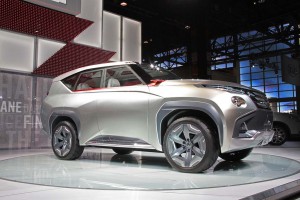Mitsubishi, remember them? The once popular marque was an alternative to traditional Japanese brands like Toyota and Honda, and offered such intriguing products as the 300GT and the Evo. After a series of missteps that nearly drove it into bankruptcy, Mitsubishi is struggling to regain some momentum with a barely-there line-up that will increasingly be focused on utility vehicles.
We’ve seen some intriguing hints of what might be coming in the form of some recent, over-the-top concept vehicles like the GC-PHEV that was unveiled at the Chicago Auto Show last February. Mitsubishi insiders promise that we’ll see these edgy prototypes translate into production form with the launch of the new Outlander Sport a few years from now.
In the meantime, Mitsubishi is updating its other crossover model for 2016, and while the Outlander adopts a far less extreme design language, it is definitely not going to get lost in the crowd.
To avoid any confusion, we need note that other than the word, “Outlander,” the two Mitsubishi utility vehicles have little in common. The Sport is the smaller of the two and seats five. Measuring 184.8 inches, the three-row Outlander can seat seven. Stuff in seven is probably a better way of putting it, as the third row is largely for kids – or adults you might not be keeping as friends if you’re expecting them to sit back there for more than just a short jaunt.
(Mitsubishi says it’s here to stay – but in what form? Click Here to find out.)
Visually, the 2016 Mitsubishi Outlander undergoes a number of changes, many of them intended to improve aerodynamics which, in turn, helps boost mileage and reduce cabin noise.
The most significant revisions can be seen nose-on in the form of the distinctive “Dynamic Shield” grille. Automakers have been working hard to give their brands distinctive faces, and Mitsubishi is no exception. The look is aggressive, and a bit reminiscent of the spindle grille styling of Lexus, with chrome accent bars linking the new headlamps and foglamps.
A silhouette shows that the basic shape of the new 2016 Mitsubishi Outlander has been revised only slightly. New chrome garnish moldings have been added to the base of the doors. From the rear, meanwhile, there are new horizontal LED taillights and a modified tailgate that now swings nearly 2 inches higher than before for easier access to the cargo bay.
(Click Here to check out the radical Mitsubishi GC-PHEV concept.)
The interior has received a number of much-needed updates, as well, largely meant to give the cabin a more elegant and upscale feel. The cheesy fake wood accents have been replaced, there’s new contrast stitching, and even the familiar Mitsubishi star on the steering wheel has been revised to show a little pride of brand.
But for us, the most welcome changes can be found clustered around the ’16 Outlander’s infotainment system. We have yet to understand why automakers have become so enamored of touchscreen displays. Sure, they may be great on a smartphone or a tablet computer, but trying to enter a command while you’re bouncing around on the highway can be a frustrating chore – especially if it’s something as basic as adjusting volume or changing stations. For 2016, Mitsubishi has gone almost retro. They’ve added back a number of welcome knobs, including those for volume and tuning. (Do you hear that, Toyota, Honda and Cadillac?) That alone earns an extra star in our ratings.
(All-new 2016 BMW 7-Series introduces gesture control technology. Click Here to find out more.)
Mitsubishi is expecting most 2016 Outlander buyers to opt for the updated 2.4-cylinder inline-four. The package makes 166-horsepower and 162 pound-feet of torque, a bit on the light side for a vehicle of this size, and only able to muster 0 to 60 times of around 10.2 seconds, using Mitsubishi’s numbers. The four-banger is paired with an updated Continuously Variable Transmission, and while we’re not enamored of CVTs, it is one of the better ones on the market, exhibiting little of the rubber band effect that can be so unpleasant under hard acceleration.
The upgrade engine is a 3.0-liter SOHC V-6 – in fact, the last V-6 offered by a Japanese maker in this segment. It’s by no means a rocket but does give a little more oomph to the 3,300-pound Outlander with its 224-hp and 215 lb-ft of torque. It’s also paired with a more crisp-shifting 6-speed automatic.
A third version of the Outlander, with a plug-in hybrid engine, arrives in mid-2016 calendar-year.
About that time, Mitsubishi also plans to offer the new Apple CarPlay smartphone integration system. And it will also bring in several much-appreciated safety features, such as blind-spot alert and cross-traffic alert.
The lack of those two technologies is a notable gap, Mitsubishi officials acknowledged, but they didn’t want to delay the launch of the 2016 Outlander to get them into production. That said, the ute does have several other important safety features, including forward collision warning with brake mitigation. That’s enough to get the Outlander a Top Safety Pick Plus rating from the Insurance Institute for Highway Safety.
Mitsubishi executives made much of the imp/wp-admin/post.php?post=95311&action=edit&message=10roved road manners of the four-cylinder Outlander before our first drive near San Francisco. We still found the 2016 model a little numb when it came to steering, and a little less sure-footed than we’d like. Surprisingly, we also found the V-6 version to offer more direct and linear steering, with a better sense of road feel that could be the result of the extra weight up front.
Where the 2016 Mitsubishi Outlander delivers is in its unexpectedly quiet cabin. Along with those aerodynamic improvements, the maker has made a total of 31 improvements – by its own count – to seal up the interior. It’s not Lexus quiet, but it’s far better than you’d expect of a vehicle in this price range.
And speaking of price, Mitsubishi took $200 off the base, front-drive SE model which now starts a $23,845 plus destination fees. You’ll have a hard time finding anything with room for seven at that price. There are a handful of upgrade packages, such as the $1,900 Premium which includes moonroof, 710-watt Rockford Fosgate audio with satellite radio and power tailgate. Load up the V-6 and you’ll nudge just over $35,000.
Is it worth it? The reality is that relatively few U.S. buyers will even consider the 2016 Mitsubishi Outlander. The brand has largely slipped off the radar for most utility vehicle buyers. The 7-seater has a number of features that would be worth more consideration, however. It’s by no means a segment benchmark but the new Outlander shows that despite Mitsubishi’s problems, it’s far from down for the count.

